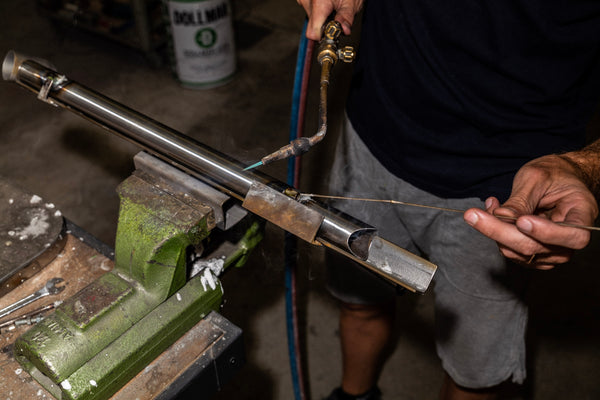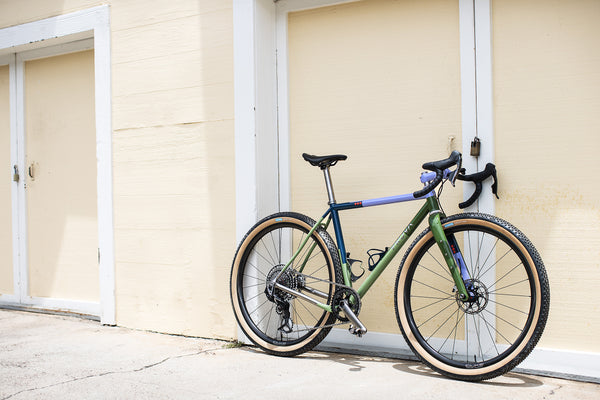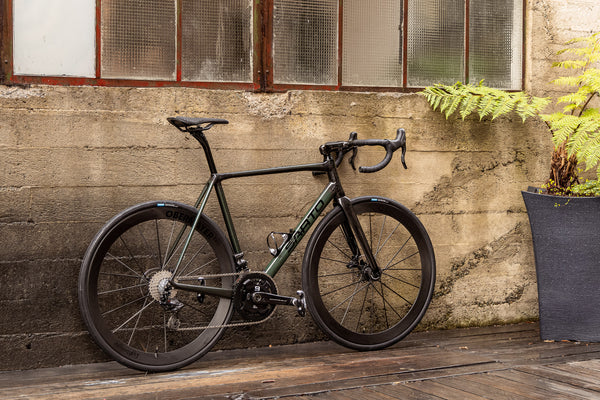As the weather shifts into spring and summer, we find ourselves answering more than a few questions on tires and new wheels, and one of the most contentious is the merits of tubular tires versus clincher tires. The debate in road cycling circles is timeless, and mostly won by clinchers. Ever the contrarians, we’d like to break the argument down into facts. At least, as objectively as we can present them. First, a grain of salt. We’re known as tubular aficionados to the core. This doesn’t meant that we shun clinchers, but when we build bikes for ourselves, our first choice for wheel/tire setups is almost always tubular. Why? Let's dive in.

The Tubular
Tubulars tires, also known as “tubies”, “tubs”, and “sew-ups”, are the original pneumatic bicycle tires, dating back to the late 1800s, and are still the primary tire of choice in the professional peloton, as well as for those who ride on the track. The construction of a tubular is more all-inclusive than that of a clincher, with the tube sewn into the tire itself. As a result, there is no need for a hook on the rim to grab the bead of the tire - instead, the tire is glued directly to the rim itself. This gives the tire a round profile instead of the squashed “U” shape of a clincher, which tends to improve the ride of the tire itself (and overall speed) - though the advent of wider clincher rims has helped negate this, to an extent.

A typical tubular tire cross-section with a totally smooth rim/tire interface and round tire profile.
The lack of a bead hook also drops a significant amount of weight from the rim itself - for example, a set of Zipp 202 tubular wheels is 270g (or .6lbs) lighter than its clincher equivalent (with good reason, the bead hook of a clincher tends to be overbuilt to hold the pressure of a clincher, as well as dealing with braking heat). Tubulars are also - arguably - safer in case of a catastrophic flat. A clincher tire can come off the rim at speed in case of rapid deflation, while the tubular will stay glued to the rim. In fact, we’ve ridden a flat tubular 50km to the finish of a race after being left behind by neutral support (note: Not recommended, unless you’re on a professional team and equipment becomes...disposable). A tubular tire can be run at lower pressures than a clincher, as there’s nothing to pinch the tube between the rim and ground (a “snakebite” puncture). As a result, they can theoretically be run at much lower pressures than clinchers. And, anecdotally, they’re more difficult to puncture, period. The lower pressures may result in roadside debris causing the tire carcass to deflect, rather than allow the foreign object to penetrate the tire and tube.

How to spot a tubular - the basetape is peeking out just a hair at the rim/tire interface.
Featherweight and magic carpet ride aside, what’s the downside to riding on tubulars? The biggest one on most riders’ minds is flats. While the flats may be few and far between, they can be catastrophic, right? Not entirely true. At AC, our tubular flat kit consists of a two-step method for getting rolling after a puncture. First, a bottle of Orange Seal tire sealant and valve core tool. If the puncture is small - glass, nail, sharp pebble - it’s our go-to. We remove the offending object, unscrew the valve core, and use the hose to inject a small amount of sealant into the tube. Then replace the valve core, partially reinflate the tire, and give it a good spin. Then, use gravity to your advantage, and put the puncture at the bottom of the wheel’s rotation. The sealant should do the rest, at which point, fully inflate the tire and ride on. We’ve found this usually lasts the life of the tire.

Occasionally, we’re not so lucky - for big gashes, cuts, and sidewall slashes, replacement of the tire is in order (and in these cases, a clincher tire would likely be done for, anyway). For this, we have a spare tire, usually lashed to the bottom of the saddle with a toestrap. Typically it’s one near the end of its wear life that we’ve previously ridden on, and has a film of glue on the bottom from when it was last mounted mounted. This is typically sufficient to get the rider home. Simply wiggle a tire lever under the flat tire, and slowly peel it off the rim (too much of a forceful effort will often either leave the tire’s basetape on the rim, or remove carbon from the rim bed). You want as much of the glued rim surface as possible for the spare tire to adhere to. Unroll your spare, and mount it to the rim - this should take even less effort than mounting a clincher, if the tire is used. Partially inflate the tire, and seat it straight into the rim bed. Then, fully inflate, and ride home. Carefully. While the glue on the tire/rim is always semi-viscous and will bond together, it’s still not as secure as a real glue job. It’s worth noting that in higher-pressure road applications, much of the work in keeping the tire attached to the rim is done by the force of the inflated tire. Once you’re back to safety, it’s time to glue a brand-new tire on the rim, and the spare can resume its duties tucked safely under the saddle.

A perfectly folded spare tubular.
On the topic of safety: Rarely, tubulars do come off rims, and usually in extreme circumstances like crashes, or like in the case below, when a friend lends you a pair of wheels with rotten tires. Rule of thumb? Check the glue before you ride, especially if the wheels have been sitting for awhile. Try to push the tire off the rim with your thumbs. Glue gives way, or the tire budges? Time for new rubber.

A case of rotten basetape.
The Clincher
The omnipresent tire that most cyclists have known since they began riding. They’re easy to work on - installation at home is a breeze without glue or special knowledge, and they’re quite a bit cheaper than tubulars. However, as a system, they’re heavier than tubies, they typically offer poorer ride quality, and are more flat prone. There’s also the potential safety issue of losing a tire at high speed. But, clinchers - tires and wheels - have come a long, long way in 20 years. While you'll still give up a quarter to a half pound of rotating mass to use them, a decent pair of carbon clinchers with a set of high-end tires can easily serve as double-duty race and training hoops for the average rider.

How many riders does it take to change a flat clincher?

The familiar U-shaped profile, and clincher bead/hooks.
Tubeless?
Finally, the word weighing heavy on everyone’s minds: Tubeless. The newest breed, a carryover from the powersports world, and then mountain bikes. Tubeless tires are simply clinchers without tubes (imagine that). Tubeless offers a few benefits: Weight (no tube, though it’s replaced by sealant), the ability to run low pressure because you can't pinch a tube that isn't there (especially helpful offroad), grip/rolling resistance (less pressure and less friction because there’s no tube to rub around inside the tire casing), and puncture resistance (sealant plugs holes when it's floating around in just a tire carcass much better than inside a deflating tube). There are a few glaring downsides when it comes to the road side of things. Good racing tires are still tough to come by. They're quite messy, and sometimes a total nightmare to install, especially at home without a compressor. Going off that, when they do flat (rarely), they can be an absolute nightmare to install a tube in. Tolerances on a tubeless tire/rim interface are much tighter than a tubed clincher to help keep disaster at bay. Seating the bead properly on the side of the road can be extremely difficult.

No tubes - no worries? Not so fast.

Road tubeless shines in #roadbikesoffroad applications, thanks to anti-flat sealant.
There are also some safety concerns with tubeless, beyond that of standard clinchers. Tire pressure is an exponentially multiplying thing when it comes to force (akin to drag coefficients or launching rockets into space). At higher road pressures, there's an extraordinary amount of force exerted on the tire bead. A bump, a hit, a jostle, and there's a chance that bead will slip or deform from the rim hook it's attached to. Since that bead/rim interface is the only thing holding air in the tire (aside from sealant), when it becomes disrupted, air flows out. This is commonly known as "burping" in the mountain bike world. In a high pressure, and high speed environment as on a road bike, this can be absolutely disastrous. On a mountain or gravel bike running low pressure, it's far less of a concern. Speeds are lower, tires are stiffer, pressure is lower, and total air volume is higher, mitigating most of the risk we see on a road bike. But, like clinchers in general, technology is coming a long way - and we’ve ridden tubeless road tires quite a bit with few incidents of the above.

So, where does that leave us? Most of the time, we still pull our tubulars down from the rafters for daily riding, but when winter storms roll in and we find the roads covered in debris during 20-hour base mile weeks, we’ve been known to eventually cave to a set of alloy clincher wheels, simply because of cost. Ruining rubbers that cost over $100 each on a weekly basis gets tiresome. Literally. Luckily, in Northern California, our roads are typically free of debris, and we can usually get away with counting on one hand the number of flats we get in a season. Armed with that logic, the tubulars are almost always worth it, but we’re excited to see future developments in tubeless and clincher tech all the same.

Thanks for reading. Any other tire/wheel questions? Give us a shout. We're listening.








Back to Journal